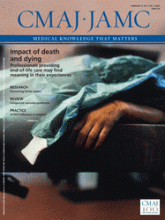Caring for dying patients can be satisfying

Image courtesy of © 2011 Jupiterimages Corp.
Palliative care professionals providing end-of-life care feel largely positive about their experiences. In this ethnographic enquiry, Sinclair interviewed 30 professionals in palliative and hospice care and observed them in their clinical work. Eleven main themes were identified. Although the end of life presents challenges, the repeated exposure to death and dying was not viewed as necessarily negative. Many participants found that their experiences fostered meaning in the present and curiosity about the continuity of life. See Research, page 180
Although some studies have shown that physicians can have intense reactions to a patient’s death, others have shown that many physicians have satisfying experiences. What makes the difference? McGrath and Kearsley argue that major barriers still exist in medical culture that prevent positive outcomes. See Commentary, page 169
Diabetes control needs managed care

Image courtesy of © 2011 Jupiterimages Corp.
Management programs for diabetes care can produce moderate improvements in the control of the disease. Pimouguet and colleagues included 41 randomized controlled trials in their meta-analysis examining the effect of organized and proactive care on blood concentrations of hemoglobin A1C. A high frequency of patient contact and the ability for disease managers to act independently in adjusting treatment appeared to be important components of effective programs. See Research, page E115
Nomograms provide better risk assessment
The risk of low-trauma fractures in the Canadian population can be assessed with reasonable accuracy using an Australian model for continuous risk prediction. Langsetmo and colleagues compared the accuracy of the Dubbo nomograms and the Canadian Osteoporosis Guidelines at predicting fractures when applied to a cohort of 5758 Canadian men and women who were followed for 10 years. Use of this approach has the potential to improve clinical decisions for men and women with osteopenia. See Research, page E107
Absolute risk calculators improve fracture-risk prediction and should be used in clinical practice, says Bolland. Calculators should be validated in local cohorts before clinical use. See Commentary, page 171
Room for improvement in folate status

Image courtesy of © 2011 Jupiterimages Corp.
Very few Canadian are folate deficient, and some have higher levels than are recommended. However, a fifth of women of childbearing age have suboptimal levels for preventing congenital neural tube defects. These findings by Colapinto and colleagues are based on 5373 people who had blood taken as part of the Canadian Health Measures Survey of 2007–09. See Research, page E100
Health lessons from Canada’s circumpolar neighbours

Image courtesy of © 2011 Jupiterimages Corp.
Health and health care in Canada’s North could benefit from sharing best practices and building evidence-based policies with its circumpolar neighbours, report Young and colleagues. Despite high health expenditures, health outcomes are poor in Canada’s North. Yet Nordic regions achieve excellent outcomes with relatively modest expenditures. The authors advocate for research and partnerships. See Analysis, page 209
Severe necrotizing pneumonia in a child with pandemic (H1N1) influenza
Although routine pneumococcal vaccination has decreased the incidence of pneumococcal pneumonia in children, complicated disease, such as pleural effusions, empyema, lung abscess, has actually increased. Co-infection with pandemic (H1N1) influenza may also contribute to severe disease. See Practice, page 215
Pandemic (H1N1) infection and pneumomediastinum in children
Udupa and colleagues report on several children with pandemic (H1N1) infection in whom subcutaneous emphysema and pneumomediastinum also developed, an association not reported in adults. Because each child had a history of asthma, the authors postulate that asthma may increase the risk of airway epithelial injury or alveolar rupture. See Practice, page 220








